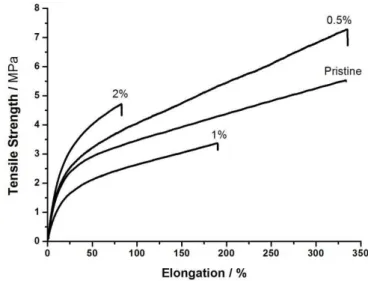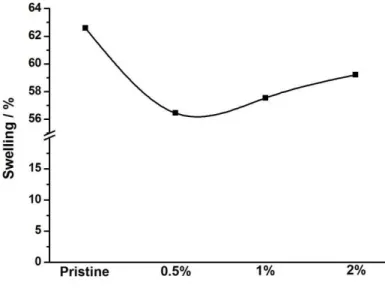ISSN 1517-7076 artigo e-11845, 2017
Corresponding Author: Heloísa Augusto Zen Received on: 24/08/2016 Accepted on: 27/10/2016
10.1590/S1517-707620170002.0178
Effect of clay incorporation in the dimensional
stability of FKM nanocomposite
Heloísa Augusto Zen1, Ademar Benévolo Lugão1
1 Instituto de Pesquisas Energéticas e Nucleares (IPEN / CNEN - SP), Av. Professor Lineu Prestes, 2242, 05508-000 São Paulo, SP, Brasil
e-mail: helozen@ipen.br; ablugao@ipen.br
ABSTRACT
In this work was studied the effect of nanoparticle incorporation in the dimensional stability of elastomer matrix. To avoid excessive swelling and consequently dimensional instability in the films, crosslinking has been shown to be an efficient and simple method for achieve the reducing membrane swelling and improving mechanical stability. The elastomer used was a fluorinated type, with 70% of fluor in its composition and commercial clay (Cloisite®) was the nanofiller used. The nancomposites with 0.5, 1 or 2% (wt%) of nanoclay were prepared in a open two roll mill. The fluoroelastomer was a type of Viton® (DuPont) which has low fuel permeation and suitable for use as sealant mainly for o-ring production. The incorporation of clay in the polymer matrix aimed to avoid excessive swelling and to maintain the material dimensional stability. The nanocomposites were characterized by stress–strain test to evaluated elongation and tension at break, by rheometry to analyzed maximum and minimum torques, and degree of swelling to follow dimensional size modification of nanocomposites films. There were a decreasing of the elongation at break and of degree of swelling values what can be correlated to an increase of crosslinking, and consequently formation of a networking in the nanocomposites matrix in the films evaluated
Keywords: Nanocomposite, fluoroelastomer, clay.
1. INTRODUCTION
Nanocomposites are a new classification of material that has at least one of its dimensions in a nanometer scale dispersed in another material. Montmorillonite clay has been used as nanofiller because of inherent properties like high aspect ratio, ion exchange capacity, plasticity, mechanical resistance, solvent resistance, among others. The incorporation of nanofiller at low content (below 10%, wt%) has the objective of to improve some properties in the polymer matrix, as mechanical, barrier to gases and inflammability.
Polymer/clay nanocomposite has been attracted large interest in industry and in the university. Rooj et al studied [1] the incorporation of organomontmorillonite (OMT) in natural rubber to investigate the mechanical reinforcement in the nanocomposites developed. Chang et al. [2] prepared nanocomposites based on styrene-ethylene/butylene-styrene (SEBS) incorporated with Cloisite 20A and after dynamic-mechanical analysis they verified an increase in the hardness and the storage modulus.
Nanocomposites of polymer/clay can be prepared by many methods, such as in situ [3, 4], polymerization interaction [5], solution interaction, co-coagulating of rubber latex and from aqueous clay dispersions [6], and with rubber matrix the major process to obtain nanocomposites is the use of a two roll mill [7, 8] . Melt interaction process is another method studied by many authors to produce nanocomposites [9, 10]. Organo-montmorillonite (OMMT)/fluoroelastomer (FKM) nanocomposites were prepared by melt intercalation by Gao and co-authors [11]. They concluded that when the OMMT content was lower than 12 wt.%, the tensile properties of the nanocomposites increased with the OMMT content.
2. MATERIALS AND METHODS
2.1 Materials
The fluoroelastomer compound (FKM) used in this work was based on Viton® F (DuPont), which is applied in large scale in automotive industry. The FKM used was obtained from three monomers, vinylidene fluoride, hexafluoropropylene and tetrafluoroethylene, containing carbon black and inorganic fillers, with 70% of fluor content.
The clay used was the Cloisite® 15A (OMMT) (by Southern Clay) which is a natural montmorillonite modified with a quaternary ammonium salt with typical dry particles size about 13µm. This modification produces a organophilic clay with a larger interlayer spacing. The clay was incorporated at 0.5%; 1% and 2% (wt%).
2.1 Methods
The incorporation process of clay into FKM was made in a open two roll mill at room temperature. After that all samples were vulcanized in a thermopress at 190°C for 5 minutes, in order to obtain a nanocomposite film with 0.2mm thickness.
The results showed in this work were the averages of five readings for all characterization techniques applied. The mechanical tests were carried out in a Texturometer with 50N load, at room temperature and samples were produced in stripes format with dimensions: 10mm of length, 0.2 mm of thickness and 80mm of height, these tests were carried out based on ASTM D 412. The hardness was measure according to ASTM D 2240.
The vulcanization behavior of the unfilled and clay filled FKM was determined using a Monsanto rheometer. Maximum torque (MH) corresponds to maximum state of cure, minimum torque (ML) is the minimum state of cure, torque variation (ΔS) and T90 (90% of the maximum cure) were calculated from the torque –time curves, according to ASTM D 2084.
Swelling of vulcanized samples was measured gravimetrically in methyl ethyl ketone (MEK), which act as a solvent for FKM. Samples were weighed before immersion, at room temperature, and after 7 days the samples were wiped dry and weighed again. The degree of swelling was calculated using Eq. 1.
%�������� = � − �� ∗ (1)
3. RESULTS AND DISCUSSION
3.1 Mechanical properties of the fluoroelastomer and nanocomposite films
The unvulcanized samples were characterized by rheometer technique. The values of ΔM and T90 are shown in Table 1.
Table 1: Torque and vulcanization time of FKM and nanocomposite samples
Sample T90 / min ΔS / lb
FKM 1.5 27
FKM-0.5% 1.3 28
FKM-1% 1.3 26
FKM-2% 1.8 21
The introduction of a small amount of OMMT increased the mechanical properties. The significant reinforcement of OMMT was caused by the good dispersion in FKM. The OMMT layers interact with rubber chains to form a network, in which OMMT acts as physical cross-linking junctions [5].
occur. Consequently a limited motion of rubber chains is identified because the OMMT filled the free space between the chains [12], so that the tensile strength increased and the elongation at the break decreased (Fig. 3).
Figure 1: Tensile strength and elongation of FKM and nanocomposite films
Hardness is a value that indicates the reinforcement effect on rubber matrix caused by the nanofiller incorporation. The increase of stiffness is directly related to an increase of the reinforcement effect in the polymer matrix and in the crosslinking reactions.
In Fig. 2 is described the values of hardness Shore A for FKM and nanocomposite. Evaluating the results was possible to confirm the reinforcement effect produced by the OMMT in the FKM matrix due to the higher hardness presented in the nanocomposite when they were compared to the FKM rubber.
Figure 2: Hardness variation of FKM and nanocomposite samples
The films were cut off in a size of 3cmx3cm and 0,2mm of thickness. After 7days of swelling, all samples remaining with the same size and thickness. Despite of the dimensional stability, according to the results of degree of swelling (Fig. 3) was observed a decrease in this parameter for all nanocomposites developed in relation of the film without clay nanoparticle.
This behavior is related to a restriction of solvent penetration into the bulk of the polymer caused by the nanofiller–polymer network (crosslinking) formed. The degree of swelling of a polymer in a solvent depends on its structure and can be related to the properties of the polymer matrix, such as chain mobility, phase interaction and free volume. As filler preferentially reinforces the rubber matrix, its introduction should reduce the volume swell of the rubber matrix and, consequently reduce the volume swell of the nanocomposites in MEK.
This decrease in the swelling is accordance with the remaining size of the films and corroborated the mechanical tests.
Figure 3: Swelling degree of FKM and nanocomposites films after vulcanization
4. CONCLUSIONS
Nanocomposites were successfully developed by mixing process in a two roll mill. The effect of incorporation nanoparticle was predominantly crosslinking in the polymer matrix. The results of mechanical tests indicated the crosslinking bonds due to the decrease in the elongation associated to an increase in the tensile strength. The behavior is a directly relation with the increase of amount of nanoparticle. These results of mechanical tests were corroborated by the swelling degree which presented a decrease in the degree of swelling confirming the crosslinking without changing the dimensional stability.
5. ACKNOWLEDGMENTS
The authors thank CNEN for financial support.
6. BIBLIOGRAPHY
[1] ROOJ S., DAS A., STOCKELHUBER K.W., et al, “Understanding the reinforcing behavior of expanded clay particles in natural rubber compounds”, Soft Matter, v. 9, pp. 3798–3808, 2013.
[2] CHANG, Y.W., SHI, J.Y., RYU, S.H., “Preparation and properties of styrene-ethylene/butylenes-styrene (SEBS) clay hybrid”, Polymer International, v. 53, pp. 1047-1051, 2004.
Technolo-gy, v. 88, pp 138 -146, 2015.
[4] OKAMOTO, M., MORITA, S., TAGUCHI, H., et al.,“Synthesis and structure of smetio clay-poly(methyl methacrilate) and clay-polysterene nanocomposites via in situ intercalative polymerization”,
Polymer, v. 41, pp. 3887-3890, 2000.
[5] ZHENG, J.P., WANG, J.X., GAO, S., et al., “Synthesis and characterization of PMMA/ montmorillonite nanocomposites by emulsion polymerization”, Journal of Materials Science, v. 40, pp. 4687-4689, 2005. [6] QINGSHAN, L., CONG, J., WANG, Q., “Research advances in polymer/ clay nanocomposites”, Materi-al science and technology, v. 12, pp. 618–621, 2004.
[7] MAITI, M., BHOWMICK, A.K., “Dynamic Viscoelastic Properties of Fluoroelastomer/Clay Nanocom-posites”, Polymer Engineering and Science, pp. 1777-1787, 2007.
[8] MAITI, M., MITRA, S., BHOWMICK, A.K., “Effect of nanoclays on high and low temperature degrada-tion of fluoroelastomers”, Polymer Degradation and Stability, v. 93, pp. 188-200, 2008.
[9] RAZAVI-NOURI, M., KARAMI, M., “Effect of rubber content on morphology and thermal and rheolog-ical behaviors of acrylonitrile-butadiene rubber/poly(ethylene-co-vinyl acetate)/organoclay nanocomposites”,
Polymer, v. 55, pp 6940–6947, 2014.
[10] ESMIZADEH, E., NADERI, G., BARMAR, M., “Effect of Organo-clay on Properties and Mechanical Behavior of Fluorosilicone Rubber”, Fibers and Polymers, v. 15, pp. 2376-2385, 2014.
[11] GAO, J., GU, Z., SONG, G., LI, P., LIU, W., “Preparation and properties of o rganomontmorillo-nite/fluoroelastomer nanocomposites”, Applied Clay Science, v. 42, pp. 272–275, 2008.


